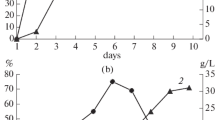Summary
Colletotrichum gloeosporioides isolated from the diseased leaves ofPolyscias balfuriana could grow and sporulate on a wide range of pH (viz. from 3.0 to 9.0). Maximum growth was recorded at pH 5.5. Mannitol was the best carbon source for growth. Good growth as well as good or excellent sporulation was also recorded on glucose, fructose, maltose and starch. Organic acids (malic and tartaric) supported poor growth.
Present organism could utilize a number of nitrogen sources. Nitrates in general were comparatively better sources than ammonium compounds. Aspartic acid was found to be the best nitrogen source for growth. Nitrites were toxic at lower pH values though they supported growth at alkaline medium. Best growth of the organism was obtained on MgSO4, 7H2O. The urea supported poor growth. ZnSO4 inhibited the growth completely. The present organism was incapable of growing in media lacking carbon, nitrogen or sulphur.
Similar content being viewed by others
References
Burger, O. F. (1924). Rev. appl. Mycol.3: 380–381.
Chaudhuri, H. &G. Singh (1930). Proc. 17th Sci. Cong. 280.
Chowdhury, S. (1947). Curr. Sci.16: 152–153.
Cochrane, V. W. &J. E. Conn (1950). Bull. Torrey Bot. Club77: 10–18.
Fawcett, H. S. (1936). Citrus diseases and their control. McGraw Hill Publications in the Agricultural Science, New York & London.
Foster, F. W. (1949). Chemical Activities of Fungi. Academic Press, New York, 648 pp.
Gottlieb, O. &D. Ciferri (1956). Mycologia48: 253–263.
Hawkins, L. A. (1915). Amer. J. Bot.2: 375–389.
Khan, A. H. (1959). Mycopathol. et Mycol. Appl.19: 289–302.
Leonian, L. H. &V. G. Lilly (1938). Phytopathology,28: 531–548.
Lilly, V. G. &H. L. Barnett (1951). Physiology of the fungi. McGraw Hill Publications, New York, 464 pp.
Mallik, P. C. &S. Hasan (1959). Sci. & Cult.25: 321–322.
Mitter, J. H. &R. N. Tandon (1930). J. Indian bot. Soc.9: 190–198.
Nord, F. F. &R. P. Mull (1945). Advances in Enzymol.5: 165–205.
Prasad, N. &R. D. Singh (1960). Curr. Sci.29, 2: 66–67.
Ramsey, G. B. (1943). U.S. Dept. Agric. Plant. Dis. Rept.27: 255.
Sattar, A. &S. Malik (1939). Indian J. agric. Sci.9: 511–521.
Steinberg, R. A. (1942). J. agric. Red.64: 455–475.
Tandon, R. N. &A. Verma (1962). Phyton,19: 49.
Tandon, R. N. &C. Chaturvedi (1963). Proc. Nat. Acad. Sci. India, Sect. B33: 361–469.
Tandon, R. N. &K. S. Bilgrami (1959). Proc. Nat. Inst. Sci. India,25: 138–142.
Tandon, R. N. &S. Chandra (1962). Mycopathol. et Mycol. Appl.18: 213–224.
Thind, K. S. &L. Duggal (1957). Curr. Sci.26: 393.
Author information
Authors and Affiliations
Rights and permissions
About this article
Cite this article
Chaturvedi, C. Nutritional studies on Colletotrichum gloeosporioides Penz. Mycopathologia et Mycologia Applicata 27, 265–272 (1965). https://doi.org/10.1007/BF02053782
Issue Date:
DOI: https://doi.org/10.1007/BF02053782




